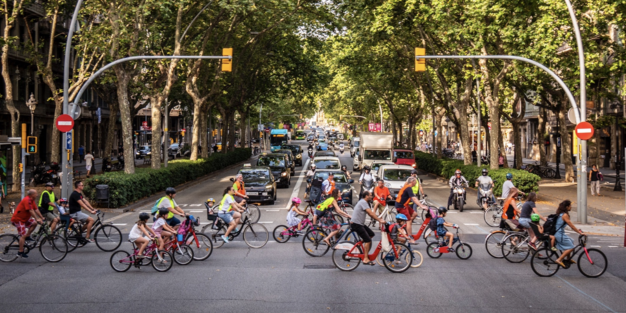
Building a global ‘Bike Bus’ community
In late March 2023, #BiciBús activists from Barcelona hosted fellow ‘bike bus’ leaders from around the world for the first-ever global Bike Bus Summit.
Since 2021, the bike bus movement has exploded. Bike buses are groups of children and parents cycling to school together on a regular route and schedule. While bike buses have been around for over a decade, the number of bike buses taking children to school has grown exponentially in the last two years, in part due to social media and viral videos showing swarms of kids cycling together.
Bike buses are fun, energetic and inspiring. Seeing bike buses online has motivated children, parents and teachers around the world to organise their own initiatives. Bike buses are fun, energetic and inspiring. Seeing bike buses online has motivated children, parents and teachers around the world to organise their own initiatives, says Jordi Honey-Rosés.

So what did we learn from the first Bike Bus Summit and where do we go from here?
We should think more carefully about child age
Bike buses attract younger children, often early primary school children. The Shawlands Bike Bus in Glasgow, for example, is comprised of children ages 6-7, with a few around age 10. A global survey of bike bus leaders being conducted at the Universitat Autònoma de Barcelona gives an average estimated age of riders of 7.8. Some Bike buses have even reported an average age of 5.
This is notable because it is not an age for which we have much research on cycling behavior. Most studies that examine cycling to school study children around age 10 or older. Nor is it the age for which many cycling programs begin training kids good cycling habits. Researchers and trainers target older children (ages 10-13) because it is easier for them to answer surveys and respond to instructions. In short, it is easier for the researchers and trainers. But is it the best timing for the kids? While it is more difficult to work with early primary school children, this is a critical age for the bike bus movement.
If these preliminary results hold, researchers and cycling advocates for kids might be better served to study and train children at a younger age. Of course, there are challenges associated with this shift in age group, but it is something that the community should think about more carefully as a movement and as advocates.
As well, how can we ensure that the younger children stay involved as they get older? At the Bike Bus Summit, we heard stories about how older children stopped going because it became too slow for them, for example. Older children (ages 10-13), especially boys, start to enjoy racing. How do we make the speed compatible with the needs of the younger children? Each age group has different needs, and we should think about how to accommodate everyone.
A global movement
The summit allowed our team at the Universitat Autònoma de Barcelona to present our ongoing work to understand the scope of the global bike bus movement. Gemma Simon-i-Mas, a PhD candidate, presented preliminary results from our global bike bus survey. So far, we have survey responses from 109 bike buses in nine countries and we are aware of the existence of 45 more bike buses that have not yet answered the survey. While still underway, we are beginning to see the scope, scale and diversity of the bike bus movement around the world. The average bike bus is a group of 16 children and 11 adults that travel to school together once a week, cycling an average of 3 kilometers (1.9 miles) and taking 21 minutes.
The Sant Antoni Bike Bus route organized by BiciBús Eixample in Barcelona. Photo: Calvox & Periche
In addition to merely describing the movement, we are looking for patterns in what makes a successful bike bus. For instance, most routes are between 2-4 kilometers. If shorter, families prefer to walk, while longer routes might take too long.
Gareth Johnson, from Shawlands Bike Bus, made the good point that we should also be studying those groups that have started a bike bus but have been unable to keep it going. What can we learn from such failed attempts? Might those experiences provide insights for those who want to create their own? Was it distance, slope, timing or something else that made it difficult?
Scale and replication: volunteers or a professional model?
A major question for the bike bus movement is how to scale. Coach Sam Balto from Alameda Bike Bus in Portland, Oregon, argued that cities and school districts can do much more. He pointed out that he was able to mobilize hundreds of children with only USD $500 to compensate parent volunteers with gift cards. He proposed a more professionalized model with paid municipal staff devoted to promoting active transportation similar to work being done by Megan Ramey in Hood River, Oregon.
Others are more skeptical of the professional model because it is top down. This view argues that it must be bottom up, led by parents and kids, or it will not succeed. While Coach Balto has organized a highly successful bike bus with a small budget, kids and families may have showed up because he was the one organizing it. His relationships and charisma made the difference. Volunteers can provide similar energy to bring in other families. Families and kids show up because they want to bike to school with their friends. A volunteer-led bike bus also generates a sense of ownership and stewardship. This view argues that successful bike buses need strong personal relationships which are not easily obtained in top-down models that attempt to parachute into schools.
And yet some also made the point that volunteerism is not sustainable, nor does it lead to consistent results. This view argues for formalization and institutionalization. Our research shows that the bike buses that have sustained themselves over the longest periods of time have support from teachers who stay at the school and are able to transmit the energy and enthusiasm from generation to generation. Volunteer-led bike buses risk disappearing once the children grow up and the leading families leave the school. This view advocates for institutionalizing bike bus through active transportation budgets. The work in Oregon to change legislation and move transportation funding from conventional school buses to active bike buses illustrates exactly the type of work needed in this direction.
There were also differing views about how to balance group size, fun and efficiency. Genís Dominguez from BiciBús Eixample in Barcelona argued that we should not set expectations that small schools need to develop large bike buses. Instead, we should envision many smaller initiatives, with fewer children.
On the other hand, from personal experience, the bike buses with the most people are the most fun. Participation with a large group provides energy and drives community. Smaller bike buses might be harder to sustain, unless there are clear practical benefits. Large biker buses can afford be less practically efficient for families, if they make up for it with fun.
Coach Balto suggested that the focus should be on active transportation to school generally, not just bikes. This view argues that we should not miss the bigger picture and wider aims that could also be achieved through “walking buses.” We agree that in an ideal city, no bike bus would be necessary because everyone would feel safe to bike or walk to school. However, in some cities, like Barcelona, the bike bus movement has been lifted by cycling advocates, making the idea of bike bus inseparable from cycling advocacy. In Barcelona at least, it would be difficult to take the bike out of the bike bus.
The Barcelona Declaration
Bike Bus Sagrada Familia route in Barcelona. Photo: Calvox & Periche
A major outcome of the Bike Bus Summit was the Barcelona Declaration. Rob Collier from Bike Bus Worcester led us through the process to craft this statement about our collective work and vision:
#BikeBus is joy and freedom. Community bike rides to school make kids happier, more awake and ready to learn. Our community becomes more connected and resilient. We demonstrate that our streets can be for children too. As a #BikeBus community, we demand that our political leaders prioritize urban space and resources for child friendly, healthy and safer streets.
I found the story of Shawlands Bike Bus particularly inspiring. A family from Glasgow, Scotland, visited Copenhagen and wondered why kids in their community could not bike to school like the kids they saw there. When they returned, they teamed up with several other families to start a bike bus. They lived close to one another, making the logistics easy. For several weeks it was just them, a small group, riding to school. But then the group grew, as more families joined. Then the media came, and soon they became a darling citizen initiative. They began working with community police and the city gave them a device that would change traffic lights to give them priority. Public officials soon reached out to the organizers to ask how more bike buses could be created. Now, the city set has a goal of creating 23 bike buses in 2023, one for each of the 23 neighborhoods of Glasgow.
It is important to recognize that the group at this inaugural Bike Bus Summit was only a small handful of the organizers and activists that have helped pushed the cause around the world. We were the fortunate ones, able to travel or take a Thursday afternoon off work to share our passion for safer streets for kids. Key friends and supporters were missing from the event, leaving us thinking about how we might organize our next gathering. Klaus and Simone Markl from BiciBus Frankfurt volunteered immediately to organize the next workshop in Frankfurt in 2024 – stay tuned!)
Organisers of bike buses from around the world traveled to Barcelona for the first Bike Bus Summit in late March 2023. Photo: Jordi Honey-Rosés/Bike Bus Summit
Perhaps the most important part of the event was simply meeting so many other passionate advocates and researchers from the community in person. While the explosion of interest in bike buses can be largely attributed to social media, relationships are consolidated in person. Meeting each other, talking about our families and trading anecdotes has cemented a stronger network of activists – and seeing how quickly talk turned to next year’s plan, I believe this is only the beginning.
Jordi Honey-Rosés is a member of the coordinating team for the Bike Bus Summit and lead researcher of City Lab Barcelona at the Institute of Environmental Science and Technology of the Universitat Autònoma de Barcelona (ICTA-UAB).
Originally published by TheCityFix.com, part of the World Resources Institute (WRI) and reproduced here under Creative Commons Licensing guidelines.







